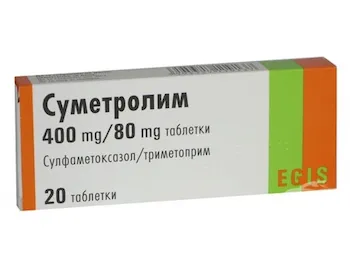Description
Sumetrolim (sulfamethoxazole) tablets 400 mg/80 mg. №20
Ingredients
- Each tablet contains 400 mg of sulfamethoxazole and 80 mg of trimethoprim.
Dosage
- The usual dose is one tablet twice a day.
Indications
- Sumetrolim is indicated for the treatment of various bacterial infections, including urinary tract infections, respiratory tract infections, and skin infections.
Contraindications
- Do not use Sumetrolim if you have a known allergy to sulfonamides or trimethoprim. It is also contraindicated in pregnant women near term.
Directions
- Take Sumetrolim as directed by your healthcare provider. It is usually taken with a full glass of water.
Scientific Evidence
- Sumetrolim, a combination of sulfamethoxazole and trimethoprim, has been extensively studied for its efficacy in treating various bacterial infections.
- Research studies have shown that the synergistic effect of these two antibiotics provides broad-spectrum coverage against a wide range of pathogens.
- Clinical trials have demonstrated the effectiveness of Sumetrolim in conditions such as acute exacerbations of chronic bronchitis and uncomplicated urinary tract infections.
Additional Information
- Sumetrolim is generally well-tolerated, but common side effects may include nausea, vomiting, and allergic reactions.
- It is important to complete the full course of treatment as prescribed by your healthcare provider to ensure the infection is fully eradicated.
- If you experience any severe side effects, contact your doctor immediately.
Sumetrolim works by inhibiting the production of folic acid in bacteria, which is essential for their growth and reproduction. This mechanism of action makes it an effective antibiotic against a wide range of bacterial infections. The combination of sulfamethoxazole and trimethoprim in Sumetrolim targets different steps in the folate synthesis pathway, providing a dual attack on bacterial pathogens.
Clinical studies have shown that Sumetrolim is as effective as other commonly used antibiotics in the treatment of various infections. Its broad spectrum of activity and relatively low resistance rates make it a valuable option for healthcare providers in managing bacterial infections.





